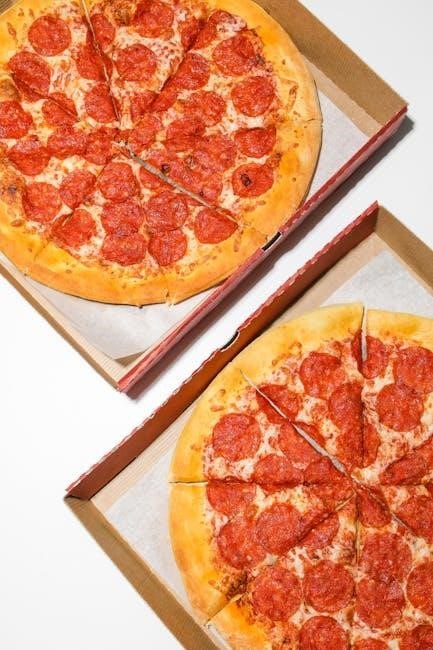The Whole30 is a transformative 30-day dietary reset focusing on whole, nutrient-dense foods. It eliminates harmful food groups, promoting health and habit changes through strict rules.
What is the Whole30?
The Whole30 is a 30-day elimination diet designed to improve health by removing potentially harmful foods. It focuses on whole, nutrient-dense ingredients like meats, vegetables, and fruits while eliminating sugar, grains, dairy, and legumes. The program aims to reset eating habits, enhance digestion, and boost energy. It’s not a calorie-counting diet but a strict reset to identify how certain foods affect your body. The goal is to promote long-term health and well-being by fostering healthier relationships with food.
Key Principles of the Whole30 Diet
The Whole30 diet focuses on eliminating potentially harmful foods to promote health and well-being. It emphasizes whole, nutrient-dense ingredients like meats, vegetables, and fruits. Key principles include avoiding added sugars, grains, dairy, legumes, and processed foods. The program also prohibits recreating treats with compliant ingredients, known as the “no pancakes” rule. By removing these foods, participants aim to improve digestion, reduce inflammation, and develop healthier eating habits. The goal is to reset your relationship with food and your body.

The Core Rules of the Whole30 Program
The Whole30 program requires eliminating added sugars, grains, dairy, legumes, and processed foods for 30 days. It also prohibits recreating treats with compliant ingredients, known as the “no pancakes” rule.
Foods to Avoid for 30 Days
The Whole30 program requires eliminating several food groups for 30 days, including added sugars, real or artificial, such as maple syrup, honey, and agave nectar. Grains like rice, quinoa, and oats are also off-limits, along with dairy products, legumes, and processed foods. Additionally, recreating treats with compliant ingredients, like pancakes or baked goods, is prohibited to avoid emotional eating and stay focused on whole, nutrient-dense foods. This strict elimination helps reset eating habits and improve overall health.
Approved Foods and Ingredients
The Whole30 program emphasizes whole, unprocessed foods, including vegetables, fruits, lean proteins, and healthy fats. Approved ingredients are free from added sugars, grains, dairy, and legumes. Fresh meats, poultry, seafood, and eggs are encouraged, along with nuts, seeds, and avocados. Vegetables like leafy greens, broccoli, and bell peppers are staples, as are fruits like berries and citrus. Healthy fats like olive oil and coconut oil are also permitted. The focus is on nutrient-dense, naturally occurring foods that align with the program’s rules.
The “No Pancakes” Rule Explained
The “No Pancakes” rule prohibits recreating treats using compliant ingredients, even if they follow the program’s guidelines. This means no pancakes, muffins, or bread, even if made with almond flour or eggs. The rule aims to break emotional ties to unhealthy foods and prevent cravings. It encourages a mindset shift, focusing on whole, nutrient-dense meals rather than indulgent substitutes. This rule helps participants avoid slipping into old habits and stay committed to the program’s goals.
Benefits of the Whole30 Program
The Whole30 Program offers numerous benefits, including improved digestion, increased energy, and weight loss. It helps reduce inflammation and enhances mental clarity, promoting overall well-being.
Physical Health Improvements
The Whole30 Program leads to significant physical health improvements. Many participants experience weight loss, improved digestion, and reduced inflammation. Energy levels often increase, and skin health may enhance. The elimination of harmful food groups can also lower blood pressure and improve cholesterol levels. By focusing on nutrient-dense foods, the program supports overall bodily functions, leading to a healthier and more balanced physical state within 30 days. These changes contribute to long-term wellness.
The Whole30 Program fosters mental clarity and emotional resilience. Participants often report reduced cravings and improved mood stability. By eliminating addictive foods, individuals break emotional ties to eating, enhancing self-control. The program encourages mindfulness and a healthier relationship with food, reducing stress and anxiety. Many find increased confidence and a sense of accomplishment, leading to overall emotional well-being. These mental and emotional benefits often extend beyond the 30-day period, promoting lasting positive changes. The Whole30 leverages nutritional science to reset metabolism and digestion. By removing inflammatory foods, it promotes gut healing and balances blood sugar, enhancing overall health naturally. The Whole30 program impacts your body by eliminating inflammatory foods, improving digestion, and balancing blood sugar. It reduces cravings, boosts energy, and enhances nutrient absorption. By removing harmful food groups, your body resets its metabolism, leading to better overall health and vitality over the 30-day period. This dietary approach helps your system recover from potential damage caused by processed foods, promoting a healthier physiological state. The Whole30 program begins with a 30-day elimination phase, removing potentially harmful foods like sugar, grains, and dairy. This allows your body to heal and reset. After the elimination period, the reintroduction phase systematically adds back foods to identify sensitivities or intolerances. This process helps you understand how specific foods affect your health, enabling informed dietary choices for long-term wellness. It’s a crucial step in achieving lasting benefits from the program. Whole30 meal planning involves creating balanced, compliant meals using approved ingredients. Templates provide structure, ensuring variety and adherence to program rules, simplifying the process. A balanced Whole30 meal template focuses on protein, vegetables, and healthy fats. Start with a protein source like meat, fish, or eggs. Add a variety of colorful vegetables, ensuring diversity in nutrients. Incorporate healthy fats such as avocado, nuts, or olive oil. Season with compliant herbs and spices for flavor. Use the Whole30 rules PDF to ensure all ingredients are approved. This structure simplifies meal planning and guarantees a nutritious, satisfying meal every time. Meal prepping is essential for Whole30 success. Start by planning meals for the week, ensuring each includes protein, vegetables, and healthy fats. Set aside one day for bulk cooking, like roasting vegetables or grilling meats. Use containers to portion meals and label them for easy tracking. Freeze meals for convenience and to avoid waste. Focus on fresh, seasonal ingredients and refer to the Whole30 rules PDF for compliant ingredients. Stay consistent and adjust based on preferences and progress. The Whole30 journey spans 30 days, divided into phases. Days 1-7 focus on detox and adaptation, while weeks 2-4 emphasize healing and habit formation. The first week of Whole30 often brings significant changes. Days 1-2 may involve cravings and fatigue as your body detoxes from sugar and processed foods. By Day 3, energy levels typically rise, and mental clarity improves. Digestive adjustments, like bloating or constipation, are common. Emotional challenges, such as food cravings, may peak around Day 5. Stay hydrated, focus on compliant meals, and remind yourself of your goals to navigate this phase successfully. Consistency is key during this initial adjustment period. By week 2, many experience increased energy, improved digestion, and mental clarity. Cravings often subside, and inflammation may decrease. Social challenges, like navigating meals with friends, become more manageable. Continue focusing on compliant meals and hydration. Adjustments may include fine-tuning portion sizes or exploring new recipes. Stay committed to the rules to maximize benefits. This phase is crucial for building sustainable habits and observing physical and emotional improvements. Consistency will set the foundation for long-term success. Reading food labels is crucial to identify non-compliant ingredients like added sugars, grains, and dairy. This helps ensure adherence to Whole30 rules and promotes healthier choices. Compliant ingredients are whole, unprocessed foods like vegetables, fruits, meats, seafood, eggs, and healthy fats. Avoid added sugars, grains, dairy, legumes, and alcohol. Check labels for hidden non-compliant additives like MSG, sulfites, and carrageenan. Ensure all packaged foods align with Whole30 standards, focusing on real ingredients without artificial preservatives. Refer to the official Whole30 rules PDF for a detailed list of approved foods and additives to avoid. This ensures a smooth and successful program experience. Hidden additives like MSG, sulfites, and carrageenan can sneak into packaged foods, violating Whole30 rules. Always read labels carefully to identify these non-compliant ingredients. Even if a product seems healthy, check for artificial preservatives, added sugars, or processed components. The Whole30 rules PDF provides a detailed list of banned additives, ensuring you avoid them. This attention to detail is crucial for adhering to the program and achieving its full benefits. Stay vigilant to maintain compliance. Stay motivated by tracking progress and sharing goals with friends. Plan meals, shop smart, and prep ahead to avoid temptation and ensure compliance with the rules. Staying motivated on the Whole30 requires commitment and mindset shifts. Track your progress, share goals with friends, and celebrate small victories. Meal prep and planning help avoid temptation. Join a community or find a partner for accountability. Remember, the program is about resetting habits, not perfection. Focus on how you feel, not just the scale. Stay informed with the Whole30 rules PDF to ensure compliance and maintain momentum throughout the 30 days. The Whole30 can test social and emotional resilience, especially when facing food-centric events or cravings. Plan ahead for gatherings with compliant meals and communicate your goals to loved ones. Emotional eating is common, so identify triggers and find healthier coping mechanisms. The “No Treats” rule helps break emotional ties to food. Stay connected with the Whole30 community for support and motivation. Remember, the program is about resetting habits, not deprivation, leading to long-term health benefits. Common mistakes include ignoring the “No Pancakes” rule, overcomplicating meals, and neglecting to read food labels for hidden non-compliant additives. Stay vigilant and focused. One common pitfall is overcomplicating recipes, leading to frustration. Others include poor meal prep, resulting in last-minute non-compliant choices, and neglecting to read labels for hidden additives. Additionally, recreating favorite treats with approved ingredients, despite the “No Pancakes” rule, can hinder progress. Staying organized, keeping meals simple, and planning ahead are key to avoiding these mistakes and ensuring long-term success on the Whole30 program. Proper preparation is essential for adherence; The “No Treats” rule addresses emotional eating by eliminating even compliant recreations of sweets and junk foods. This helps break the psychological connection between emotions and food. Many find it challenging, as it forces them to confront cravings and habits. Without treats, participants must seek comfort elsewhere, fostering healthier coping mechanisms. This rule is crucial for lasting behavior change, though it can be frustrating initially. It encourages mindfulness and reduces reliance on food for emotional support. Post-Whole30, focus shifts to reintroducing foods mindfully and maintaining healthy habits. The program aims to create a sustainable lifestyle, not a quick fix. After completing the Whole30, reintroducing foods is a gradual process. Start with one food group at a time, monitoring reactions. This step helps identify which foods may cause inflammation or discomfort. It’s crucial to track symptoms like bloating, fatigue, or skin issues. The goal is to create a personalized diet that promotes long-term health and wellness. Patience is key during this phase to ensure accurate results and informed choices.
Post-Whole30, focus on sustainable habits rather than restrictions. Incorporate nutrient-dense foods, balance macronutrients, and listen to your body. Avoid strict rules and instead, adopt mindful eating. Regular meal planning and prep support consistency. Stay hydrated, prioritize sleep, and manage stress for overall wellness. The goal is a flexible, enjoyable lifestyle that fosters long-term health without deprivation. Use the Whole30 as a foundation to build lasting, positive changes. Access essential guides like the Official Whole30 Rules PDF and printable meal templates. These resources provide clarity and structure for a successful program experience. The Official Whole30 Rules PDF is a comprehensive guide outlining the program’s core principles and restrictions. It details foods to avoid, approved ingredients, and the “No Pancakes” rule. This downloadable resource is free and essential for understanding the program’s framework. It also includes tips for success and a clear timeline, making it a valuable tool for participants. The PDF is printable, ensuring easy reference throughout your Whole30 journey. Printable Whole30 meal templates and guides provide structured plans for breakfast, lunch, and dinner. These resources help participants stay organized and compliant with program rules. They include space for grocery lists and daily reflections, making meal prep easier. The guides are designed to ensure balanced nutrition and variety, preventing meal fatigue. Available as downloadable PDFs, they offer a practical tool for tracking progress and maintaining motivation throughout the 30-day journey.Mental and Emotional Benefits



The Science Behind the Whole30

How the Program Affects Your Body
The Role of Elimination and Reintroduction
Whole30 Meal Planning and Templates
Creating a Balanced Meal Template
Practical Tips for Meal Prepping
The Whole30 Timeline

What to Expect in the First Week
Weeks 2-4: Progress and Adjustments

Understanding Food Labels
Identifying Compliant Ingredients
Avoiding Hidden Non-Compliant Additives

Tips for Success on the Whole30
Staying Motivated and Accountable
Navigating Social and Emotional Challenges
Common Mistakes to Avoid
Pitfalls in Meal Planning and Preparation
Emotional Eating and the “No Treats” Rule
Life After the Whole30
Reintroducing Foods Post-Program
Maintaining a Healthy Lifestyle Long-Term

Downloadable Resources
The Official Whole30 Rules PDF
Printable Meal Templates and Guides